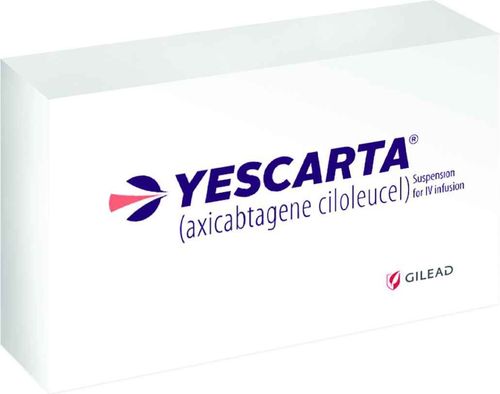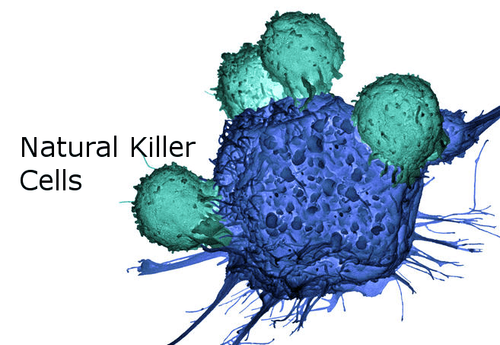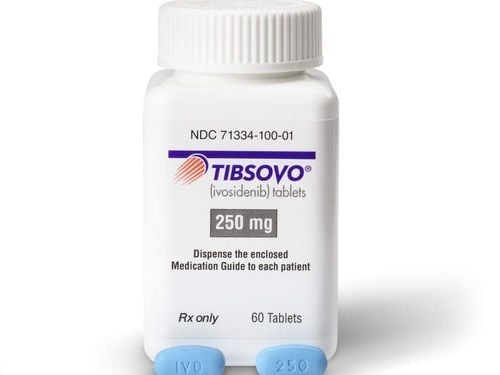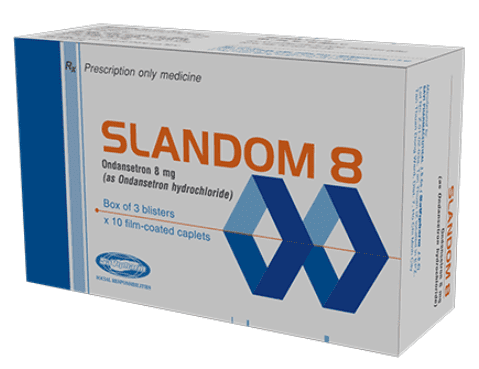This is an automatically translated article.
This article is professionally consulted by Dr. Le Tan Dat, Medical Oncologist - Radiation Therapy Center, Vinmec Central Park International General Hospital.Cancer is a common and dangerous disease that causes unpredictable consequences if not detected and treated in time. So how are cancer cells different from normal cells?
1. How are cancer cells different from normal cells?
The following are the key differences between cancer cells and normal cells, thereby explaining the formation of malignant tumors and their ability to react to the surrounding environment compared to benign tumors. .1.1. Growth Normal cells stop growing, developing, and reproducing on their own when they have enough cells. For example, when there is a cut in the skin, new cells are produced to repair and heal the wound. When there are enough cells to fill the gap caused by damage, new cells will no longer be produced, which means, cell reproduction will stop on its own. However, cancer cells do not have a mechanism to stop themselves when they have met the body's cell needs. This continued growth leads to the formation of a tumor (a cluster of cancer cells).
Each gene in the body acts as a genetic code to "encode" so each protein is different. Some of the resulting proteins are growth-stimulating factors, which are substrates for the growth and division of cells. If the gene coding for this protein is mutated and becomes an oncogene (or oncogene), the proteins that act as "growth factors" will be overproduced, non-stop. As a result, cancer cells will continuously grow and develop.
Trắc nghiệm: Thử hiểu biết của bạn về bệnh ung thư
Ung thư là nguyên nhân gây tử vong hàng thứ 2 trên thế giới. Thử sức cùng bài trắc nghiệm sau đây sẽ giúp bạn có thêm kiến thức về yếu tố nguy cơ cũng như cách phòng ngừa bệnh ung thư.
Bài dịch từ: webmd.com
1.2. Responsiveness to Other Cells Normal cells have the ability to respond to signals sent from nearby neighboring cells. Simply put, when cells grow to a certain extent, they will reach the "boundary" of neighboring cells and these "neighbor" cells will signal to stop growing. For normal cells, when they "hear" these signals, they stop growing. Meanwhile, cancer cells will not respond to such signals.

1.4. Adhesion Normal cells secrete substances that cause them to stick together as a group. In contrast, cancer cells cannot make these substances and as a result, they are "lost" to nearby sites, via the bloodstream or the lymphatic system to distant areas of the body (this is the the premise that cancer spreads everywhere in the body).
1.5. The ability to metastasize (spread in the body) Normally, cells always “reside” in an area of the body where they belong. For example, lung cells are always in the lungs. Meanwhile, with cancer cells, because of the lack of adhesions, they can separate and move into the blood vessels and lymphatic system to reach other organs of the body. is "metastasis". Once they have spread to a new area (such as a lymph node, lung, liver, or bone), these malignant cells begin to grow and form new tumors away from the original tumor.
1.6. Cell shape When viewed under a microscope, cancer cells and normal cells can look very different.
Unlike healthy cells, cancer cells are often variable in size, larger or smaller than normal. In addition, their shape is sometimes irregular, including the shape of the cell nucleus ("monster nucleus"). The nuclei of malignant cells are usually larger and darker than normal cells (because they contain more excess DNA) (usually in a state of division, or "multiplication"). If we look further, we see that the chromosomes of the abnormal cells are arranged in a disorganized fashion.
1.7. Growth Rate Benign cells reproduce on their own and then stop when there are enough cells. Meanwhile, cancer cells proliferate rapidly and have no mechanism to stop themselves.

1.9. The ability to avoid the immune system When normal cells are damaged, the body's immune system recognizes and eliminates them through lymphocytes. However, cancer cells can secrete chemicals that inactivate immune cells, in order to evade detection, and fool the immune system's recognition system for a long enough time to develop into a cancer. melanoma. Based on this mechanism, a number of new immunotherapies have emerged to address this problem during cancer treatment.
1.10. Differences in function Each normal cell will perform a certain function in the body, while cancer cells may lose their inherent function. For example, healthy white blood cells help the body fight infections. For people with leukemia, the number of white blood cells can be very high, but it loses the protective effect of the body, as a result, the patient is very susceptible to infections even when the white blood cell count is high. . As another example, normal thyroid cells produce thyroid hormone. With thyroid cancer, these cells may no longer be able to produce thyroid hormone, causing the body to become hypothyroid, even though the number of thyroid cells increases significantly.
1.11. Angiogenesis Normal cells have a mechanism to attract blood vessel formation to support growth and repair damaged tissue. However, cancer cells stimulate angiogenesis even when there is no need for growth or repair.
Therefore, a cancer treatment drug has the effect of inhibiting angiogenesis and preventing the growth of tumors through these blood vessels.
1.12. The ability to evade growth inhibitors Normal cells are controlled by growth inhibitors (inhibition of tumorigenesis). There are three types of proteins responsible for inhibiting cell growth:
The first type signals cells to slow down and stop dividing. The latter helps to repair errors and damage in cells. The third type is responsible for activating the process of “programmed cell death” (referred to in section 1.3). When mutations occur in the genome that encodes tumor suppressor proteins, it leads to excessive and uncontrolled growth of cancer cells.
1.13. Invasion Normal cells have the ability to "listen" for signals from nearby tissues to stop growing when they accidentally invade other surrounding cells (this ability is called contact inhibition). However, the cancer cells will ignore the inhibitory signal and invade nearby tissues to continue to grow.
Benign (non-cancerous) tumors also have the ability to grow, squeeze, and push into adjacent tissues, but they do not invade or merge with other tissues. Meanwhile, cancer cells are quite aggressive and invade surrounding tissues for space to grow. In fact, the name "cancer" is derived from the Latin word for "crab", used to describe the invasion with image and "horizontal" nature of cancerous tissues into healthy tissues. surrounding count.
1.14. Energy Supply Normal cells get most of their energy for their activities (in the form of energy molecules, called ATP) mainly through a special process called the Krebs cycle, with oxygen involvement. Normal cells' energy production requires the presence of oxygen, whereas cancer cells generate most of their energy in the absence of oxygen. This is the mechanism used in cancer treatment with hyperbaric oxygen.
1.15. Lifetime Cells also have a lifespan. Cells in the body cannot live forever, but like humans, they are born, grow, reproduce, then age and then die. However, cancer cells can live indefinitely and become almost immortal.
1.16. Genomic stability Normal cells have normal genomes and completely stable chromosome numbers. Meanwhile, cancer cells often have variable chromosome numbers and unstable genomes with numerous mutations. Furthermore, some mutations have the potential to promote cells that would normally become cancerous. Identifying the type of mutation helps doctors to precisely use targeted drugs in cancer treatment.
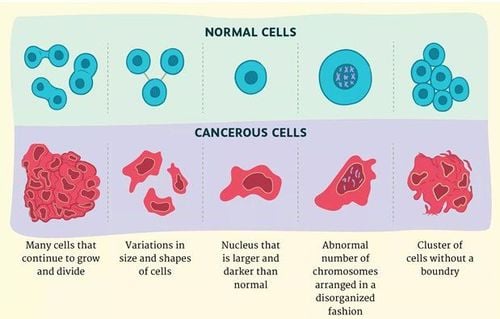
2. The ability of mutated cells to become cancerous
As mentioned, cancer cells have a lot of different characteristics from normal cells. However, in order to transform from a benign cell to a malignant cell, the cell must meet a number of mandatory characteristics:Must have growth factors, which promote cell growth and reproduction, right away. even in sufficient quantity. Must be able to avoid growth inhibitory proteins. Must avoid contact inhibition signals from other surrounding cells Must lose adhesion to normal cells and may migrate to many other organs of the body. In general, it is very difficult for a normal cell to mutate to become cancerous, but it is estimated that 1 in 3 people will develop some degree of cancer during their lifetime. The incidence of cancer is quite high because in the human body there are about three billion cells that divide continuously every day. Therefore, the possibility of a mutation at a certain position in the genome leading to the formation of cancer is not uncommon. In addition, the cause of cancer cannot be ruled out from genetic disorders or toxic chemicals from the surrounding environment.
It is from the difference of cancer cells compared with normal cells, that many modern cancer treatment solutions have been born, such as: thermotherapy and cellular immunotherapy, which are used in combination. with available conventional or conventional cancer treatments: surgery, radiation therapy, and chemotherapy/systemic therapy. Currently, these advanced cancer treatments have all been successfully applied at Vinmec Times City International General Hospital.
3. Cure cancer with hyperthermia therapy
For the first time in Vietnam, adjuvant thermotherapy for cancer treatment has been successfully applied at Vinmec Times City International General Hospital.Heat therapy has the ability to damage and kill cancer cells based on the mechanism of increasing the temperature at the tumor site or in a body area to about 41 - 43oC without affecting normal cells. often . When combining heat therapy with chemotherapy or radiation therapy, the effectiveness of cancer treatment will increase. Furthermore, heat therapy improves the body's immunity and alters the properties of cancer cells, making them more susceptible to attack and destruction.
Heat therapy has been shown to be effective even in cases where the cancer has recurred or has been treated with other methods but has not been effective. In the world, the method of thermotherapy has been applied in many places, especially in the US, Japan, Germany... in the treatment of complex cancers such as recurrent breast cancer, cervical cancer. Bowel cancer, head and neck cancer, bone and soft tissue cancer...
4. Cancer treatment with autologous immunotherapy
Safety - No dangerous side effects - No pain for the patient, and at the same time increasing the effectiveness of cancer treatment, autologous immune enhancement therapy (AIET: autologous immune enhancement therapy) has been applied. used in 10 developed countries of the world. In Vietnam, since October 2018, the Ministry of Health has licensed the application of Autologous Immune Booster Therapy at Vinmec Times City Hospital - the first place in Vietnam that is allowed to apply this method in treatment. cancer.Immunotherapy in cancer treatment is a therapy that strengthens the body's immunity in preventing and destroying cancer cells. This therapy helps strengthen the immune system of cancer patients, stimulates immune cells to work strongly, increases the ability to recognize, attack and eliminate cancer cells, and at the same time improves the effectiveness of cancer treatment. Treatment when combined with surgical, chemotherapy and radiation methods...
Oncology - Radiation Center of Vinmec Times City Hospital continuously cooperates with leading prestigious hospitals of the US, France, Korea, Taiwan, Japan... in cancer treatment, is committed to applying the most modern treatment methods, with a high level of expertise, convenience, dedication and the most reasonable cost right at the hospital. Vietnam.
To register for cancer examination and treatment at the Center for Oncology - Radiation Therapy, Vinmec Times City International General Hospital, you can contact HOTLINE: 0243 9743 556 or request an online consultation HERE THIS .
SEE ALSO:
Learn about autologous immune boosting therapy to support cancer treatment Meaning of immunotherapy in cancer treatment Thermonuclear or thermotherapy in cancer treatment





